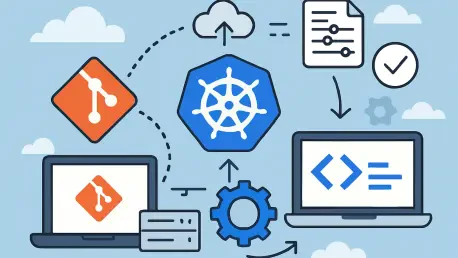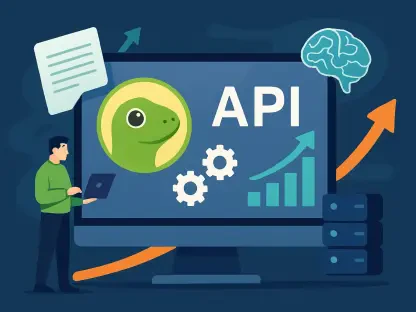In the complex landscape of Kubernetes management, a staggering number of cluster failures stem from subtle misconfigurations or unpredictable runtime errors that standard reconciliation mechanisms cannot resolve, leading to prolonged downtime. This frustrates DevOps teams as traditional controllers repeatedly attempt restarts without addressing root causes, highlighting a critical gap in automation where manual intervention becomes a bottleneck in high-velocity environments.
The emergence of GitOps-backed Agentic Operators offers a promising solution to this problem. By integrating artificial intelligence with robust policy frameworks, this technology aims to transform how Kubernetes clusters handle failures, moving beyond blind retries to intelligent, safe remediation. The focus here is on leveraging modern tools to enhance operational efficiency in cloud-native systems.
This review delves into the intricacies of GitOps Agentic Operators, exploring their architecture, real-world applications, and the balance they strike between autonomy and governance. The analysis aims to uncover whether this innovation truly represents a step toward autonomous Kubernetes management.
Unpacking the Features and Architecture
Workflow of Agentic Operators
At the heart of a GitOps Agentic Operator lies a sophisticated workflow designed to tackle pod failures with precision. The process begins with detection, where the operator monitors cluster events and identifies issues like crashes due to resource constraints. Using large language models (LLMs), it analyzes logs and events to generate a tailored remediation plan, which is then submitted as a GitHub Pull Request for review and approval.
This workflow integrates seamlessly with GitOps tools such as ArgoCD or Flux, ensuring that any proposed changes are deployed only after thorough validation. The operator continuously monitors the cluster post-reconciliation, ready to iterate with new proposals if issues persist. This closed-loop system emphasizes safety and traceability at every step.
The design prioritizes auditability by documenting each decision within a Git repository, creating a clear history of actions taken. Such transparency is invaluable for teams managing complex environments, as it allows for post-mortem analysis and continuous improvement of operational practices.
Safety Through Policy Guardrails
Safety remains a cornerstone of this technology, achieved through the integration of Open Policy Agent (OPA) and Gatekeeper. These tools enforce strict policies to validate AI-generated manifests before they are applied, preventing risky configurations such as disabling security contexts or bypassing resource limits. This layer of protection ensures that even innovative suggestions from LLMs adhere to organizational standards.
Specific policies can be customized to address unique cluster requirements, such as enforcing namespace isolation or mandating specific security settings. By embedding these checks into the remediation pipeline, the system mitigates the risk of unintended consequences, fostering trust in automated actions. This approach is particularly critical in regulated industries where compliance cannot be compromised.
The use of policy guardrails also allows for scalability, as teams can expand rule sets to cover new scenarios without sacrificing control. This adaptability ensures that the operator remains relevant as Kubernetes environments grow in complexity and diversity.
Validation via CI Pipelines
Continuous Integration (CI) pipelines, often implemented through GitHub Actions, play a pivotal role in maintaining cluster stability during auto-remediation. Before any pull request is merged, proposed changes undergo rigorous validation, including linting to catch syntax errors, dry runs to simulate application, and policy checks to enforce compliance. This multi-step process acts as a safety net against flawed fixes.
The emphasis on CI validation reflects a broader commitment to reliability, ensuring that only thoroughly vetted changes reach production clusters. Such diligence is essential in preventing cascading failures that could arise from untested modifications, especially in dynamic, multi-tenant setups.
Beyond validation, these pipelines contribute to a culture of consistency by standardizing the review process across teams. This uniformity reduces the likelihood of human error and aligns with best practices in modern software delivery, reinforcing the operator’s role as a dependable tool in Kubernetes management.
Performance in Real-World Scenarios
Practical Applications Across Industries
GitOps Agentic Operators shine in addressing common Kubernetes pain points, such as pod failures caused by insufficient memory or incorrect configurations. In practical deployments, these operators have demonstrated the ability to detect issues, propose actionable fixes through pull requests, and restore functionality with minimal human intervention. Their utility is evident in scenarios requiring rapid response to operational disruptions.
A typical demonstration involves simulating a failure, such as an out-of-memory error, and observing the operator’s response. From log analysis to PR creation, the system showcases its capacity to streamline recovery, with GitOps tools like ArgoCD applying the validated fix to restore pod health. This hands-off approach is a game-changer for teams managing large-scale clusters.
Industries with stringent reliability demands, such as finance and healthcare, stand to benefit significantly from this technology. By tailoring policy controls to meet specific regulatory needs, organizations can deploy these operators confidently, knowing that compliance and security are not sacrificed for automation. This adaptability broadens the technology’s appeal across diverse sectors.
Emerging Trends in AI-Driven Automation
The integration of AI into Kubernetes management has evolved rapidly, shifting from basic log interpretation to sophisticated remediation strategies. Agentic Operators represent the forefront of this trend, leveraging LLMs to solve complex problems that traditional self-healing tools cannot address. Their ability to adapt to novel failures sets them apart from rigid, rule-based systems.
Another notable development is the growing focus on balancing autonomy with safety. By combining AI-driven decision-making with GitOps workflows and policy enforcement, these operators mitigate risks associated with unchecked automation. This dual emphasis on innovation and governance is shaping the future of cluster management.
Looking ahead, the potential integration of local LLMs for enhanced privacy and the use of vector databases for improved reasoning are areas of active exploration. These advancements promise to refine the operator’s capabilities, making them even more effective in addressing the nuanced challenges of cloud-native environments over the coming years.
Challenges and Security Implications
Navigating Risks of AI Automation
Introducing LLM-backed automation into Kubernetes environments is not without risks, as potential security vulnerabilities and compliance issues loom large. Erroneous or malicious suggestions from AI could disrupt operations if not properly constrained, underscoring the need for robust safeguards. These concerns are amplified in sensitive domains where errors carry significant consequences.
Mitigation strategies include secure management of API keys using Kubernetes Secrets, ensuring least-privilege access, and regular key rotation to prevent unauthorized access. Additionally, enforcing strict policies with tools like OPA or Kyverno guarantees that AI outputs align with organizational security standards, rejecting harmful configurations outright.
Human-in-the-loop approvals further enhance safety for critical workloads, requiring manual review of AI-generated pull requests in production environments. This hybrid approach balances the speed of automation with the oversight necessary for high-stakes applications, addressing both technical and regulatory challenges effectively.
Ensuring Transparency and Compliance
Auditability stands as a critical requirement for any automated system, particularly in regulated industries. GitOps Agentic Operators address this by logging every recommendation, policy evaluation, and applied change, storing records in centralized systems for forensic analysis. Such transparency is essential for meeting compliance mandates and facilitating incident investigations.
Data privacy also demands attention, especially when sensitive information is processed by LLMs. Redacting personal or financial data before transmission and exploring self-hosted models for regulated sectors are prudent steps to maintain confidentiality. These measures ensure that automation does not come at the expense of trust or legal adherence.
The broader security landscape requires continuous vigilance, including securing the CI/CD supply chain with signed images and verified commits. By embedding these practices into the operator’s framework, teams can confidently deploy this technology while upholding the highest standards of operational integrity.
Reflecting on the Journey and Next Steps
Looking back, the exploration of GitOps Agentic Operators revealed a powerful blend of adaptability and safety, achieved through AI-driven remediation and policy-enforced guardrails. Their ability to transform complex failure scenarios into streamlined recovery processes marked a significant advancement in Kubernetes automation, offering a glimpse into the potential for truly autonomous cluster management.
A key takeaway from this review was the operator’s capacity to maintain auditability via GitOps workflows, ensuring every action was traceable and accountable. This feature, coupled with robust CI validation, provided a strong foundation for operational reliability, even as challenges around security and compliance required careful navigation.
Moving forward, the focus should shift to extending these operators with integrations like local LLMs for enhanced privacy and feedback loops using vector databases for smarter decision-making. Exploring these enhancements, alongside stricter human oversight for critical systems, will be crucial in refining this technology and solidifying its role in shaping the future of DevOps practices.









